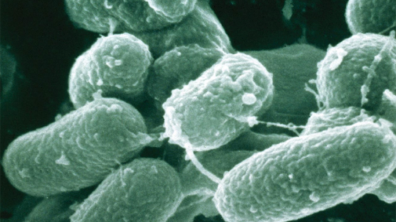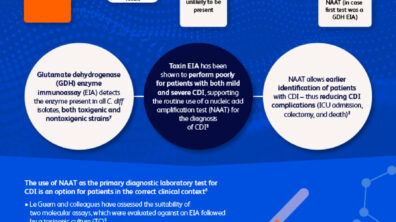
Gastrointestinal infection (GI) - February 15, 2023
Pathogens prevalence in acute gastroenteritis
Prevalence of bacterial, viral, and parasitic infection in acute gastroenteritis
Acute gastroenteritis is a common infectious disease which causes nausea, vomiting, diarrhoea, and abdominal pain usually lasting fewer than 14 days.1Annually, there are an estimated 21 million cases in France and 17 million cases in the UK.2,3 While worldwide, it affects between 3 and 5 million children and accounts for between 1.5 and 2.5 million deaths annually.4 Viruses are the culprits in 50-70% of cases followed by bacteria (15-20%) and parasites (10-15%) (Table 1).
Table 1. Infectious causes of acute gastroenteritis1
| Viral | Bacterial | Parasitic |
| 50%–70% | 15%–20% | 10%–15% |
| Noravirus | Shigella | Giardia |
| Rotavirus | Salmonella | E. histolytica |
| Enteric adenovirus types 40 and 41 | Campylobacter | Cryptosporidium |
| Astrovirus | E. coli | Isospora |
| Coronavirus | Vibrio | Cyclospora |
| Some picornaviruses | Yersinia | Microsporidium |
| C. difficile |
Note: Pathogens are listed in order of prevalence
The precise incidence and cause of acute infectious gastroenteritis is difficult to assess as not all infected individuals report their symptoms or seek medical care. Additionally, stool cultures used to identify bacterial causes of gastroenteritis only detect pathogens in 1.5% to 5.6% of cases, making it more difficult to accurately track and appropriately treat patients.1
Most common bacterial causes
jejuni and C. coli are established causes of clinically indistinguishable diarrhoea in humans. Infection with either can occur in patients of all ages, with evidence that it is more prevalent in the 1–4 and 15–24-year age groups.5 There has been a rise in global incidence of campylobacteriosis in the past decade, even though cases of C. jejuni and C. coli are likely to be underreported. In many geographic regions C. coli is less prevalent than C. jejuni, however, it contributes up to 25% of all gastroenteritis cases caused by Campylobacter spp.5
Nontyphoidal Salmonella has a high impact on global human health, causing an estimated 93.8 million illnesses (approximately 3% of diarrhoeal illnesses worldwide) – 80.3 million of which are foodborne – and 155,000 deaths each year.6
Most of the disease burden of global infection with Shigella spp is borne by children aged 1–4 years, living in low-income and middle-income settings.7 Although mortality rates have fallen over the past 30 years, approximately 164,000 annual deaths are attributable to shigellosis.7
Most common viral causes
Norovirus is the most common cause of acute gastroenteritis (one in five cases), with an estimate of 685 million annual cases.8 Two hundred million of these cases are in children under the age of five years. Although norovirus leads to an estimated 50,000 child deaths every year, mostly in developing countries, it is not restricted to low-income countries and is frequently the source of outbreaks in close quarters (e.g., cruise ships)8–10. Norovirus infections result in an estimated $60 billion annually due to healthcare costs and lost productivity.8
Rotaviruses are common, widespread and a leading cause of severe, dehydrating gastroenteritis; most children will be infected by the ages of 3–5 years.11 In 2013 alone, they were associated with an estimated >200,000 fatalities in children <5 years old globally.11 The prevalence of rotavirus infection in children hospitalised with diarrhoea is approximately 30 –50%, however >90% of children with fatal rotavirus infections live in low-income countries.11 Countries that have implemented rotavirus vaccination programmes have had a notable decline in the number of acute gastroenteritis cases, particularly in countries with low child mortality, among younger age groups, and in countries with higher coverage.12
Enteric adenovirus types 40 and 41 are one of the most important agents of acute gastroenteritis among infants and young children less than 2 years of age, with rates varying depending on country (1–8% in developed countries; 2–31% in developing countries).4
Most common parasitic causes
Giardia lamblia (also referred to as Giardia intestinalis and Giardia duodenalis) is the most common intestinal parasite in the world, affecting approximately 200 million people in Asia, Africa, and Latin America.13
Another common parasitic cause of infectious diarrhoea is Entamoeba histolytica, which affects 50 million people annually.14 This pathogen shares morphological similarities with Entamoeba dispar, a typically non-pathogenic parasite.15 Due to their similarities in appearance, microscopy cannot differentiate between the 2 parasites, which can lead to false-positive results.15
Molecular testing for gastroenteritis
Conventional culture tests are still the routine testing methods for the diagnosis of bacterial enteropathogens and pathogens detected from culture – testing can be sent for further identification, outbreak investigations, and epidemiological studies.16 Although the specificity of culture testing is 100% if no pathogens are present in healthy specimens, the sensitivity of these tests are usually low, difficult to determine, requiring 3–5 days to detect pathogens and to finalize reports. 16 They also require highly trained staff, especially for parasite microscopy, and specific equipment to detect some of the pathogens in the clinical specimens.16
Antigen detection is another popular testing method to detect certain intestinal parasites and viruses. 16 They can be done using commercially available immunoassays, but generally have low sensitivity and do not detect all the gastrointestinal pathogens.16
The emergence of commercially available nucleic acid amplification tests (NAATs) has allowed for easier detection of pathogens.16Common single molecular assays are used for the detection of many pathogens that cause gastroenteritis.16These assays can target specific patient populations and can be simultaneously tested using multiplex platforms, which have multiple testing panels. To exploit this feature, a targeted syndromic approach can be used in which multiple pathogens associated with a particular syndrome can be tested at once, saving time and costs and providing better patient management by enabling earlier initiation of treatment.17
NAAT-based technologies have helped overcome some of the challenges that arise from traditional microbiological and culture methods.16The high throughput, sensitivity and specificity of molecular-based testing provided by NAATs allow rapid diagnosis, treatment and management of gastrointestinal infections.16The COVID-19 pandemic revealed what was lacking in diagnostic testing, bringing about a greater awareness of molecular diagnostics. These technologies have great promise for non-COVID-testing and can deliver test results faster, potentially leading to earlier diagnosis and intervention and more rapid assessments of trends in incidence.18
References
- Graves NS. Acute gastroenteritis. Primary Care – Clinics in Office Practice 2013;40:727-741.
- Rivière M, Baroux N, Bousquet V, et al. Secular trends in incidence of acute gastroenteritis in general practice , France , 1991 to 2015. 2017:1-8.
- Public Health England. Gastrointestinal infections: guidance, data and analysis. 2018:1-5.
- Dashti AS, Ghahremani P, Hashempoor T, et al. Molecular Epidemiology of Enteric Adenovirus Gastroenteritis in under-Five-Year-Old Children in Iran. Gastroenterology Research and Practice 2016;2016.
- Kaakoush NO, Castaño-Rodríguez N, Mitchell HM, et al. Global epidemiology of campylobacter infection. Clinical Microbiology Reviews 2015;28:687-720.
- Majowicz SE, Musto J, Scallan E, et al. The global burden of nontyphoidal salmonella gastroenteritis. Clinical Infectious Diseases 2010;50:882-889.
- Kotloff KL, Riddle MS, Platts-Mills JA, et al. Shigellosis. The Lancet 2018;391:801-812.
- Centers for Disease Control and Prevention. Norovirus Worldwide. Centres for disease control 2018. Available at: https://www.cdc.gov/norovirus/trends-outbreaks/worldwide.html?CDC_AA_refVal=https%3A%2F%2Fwww.cdc.gov%2Fnorovirus%2Fworldwide.html.
- Carling PC, Bruno‐Murtha LA, Griffiths JK. Cruise Ship Environmental Hygiene and the Risk of Norovirus Infection Outbreaks: An Objective Assessment of 56 Vessels over 3 Years. Clinical Infectious Diseases 2009;49:1312-1317. Available at: https://academic.oup.com/cid/article-lookup/doi/10.1086/606058.
- Verhoef L, Depoortere E, Boxman I, et al. Emergence of New Norovirus Variants on Spring Cruise Ships and Prediction of Winter Epidemics. Emerging Infectious Diseases 2008;14:238-243. Available at: http://wwwnc.cdc.gov/eid/article/14/2/06-1567_article.htm.
- Crawford SE, Ramani S, Tate JE, et al. Rotavirus infection. Nature Reviews Disease Primers 2017;3.
- Burnett E, Parashar UD, Tate JE. Global Impact of Rotavirus Vaccination on Diarrhea Hospitalizations and Deaths Among Children <5 Years Old: 2006–2019. The Journal of Infectious Diseases 2020;222:1731-1739. Available at: https://academic.oup.com/jid/article/222/10/1731/5755890.
- Feng Y, Xiao L. Zoonotic Potential and Molecular Epidemiology of Giardia Species and Giardiasis. Clinical Microbiology Reviews 2011;24:110-140. Available at: https://journals.asm.org/doi/10.1128/CMR.00033-10.
- Saidin S, Othman N, Noordin R. Update on laboratory diagnosis of amoebiasis. European Journal of Clinical Microbiology and Infectious Diseases 2019;38:15-38.
- Madison-Antenucci S, Relich RF, Doyle L, et al. Multicenter Evaluation of BD Max Enteric Parasite Real-Time PCR Assay for Detection of Giardia duodenalis, Cryptosporidium hominis, Cryptosporidium parvum, and Entamoeba histolytica. Fenwick BW, ed. Journal of Clinical Microbiology 2016;54:2681-2688. Available at: https://journals.asm.org/doi/10.1128/JCM.00765-16.
- Amjad M. An Overview of the Molecular Methods in the Diagnosis of Gastrointestinal Infectious Diseases. International Journal of Microbiology 2020;2020.
- Chang L-J, Hsiao C-J, Chen B, et al. Accuracy and comparison of two rapid multiplex PCR tests for gastroenteritis pathogens: a systematic review and meta-analysis. BMJ Open Gastroenterology 2021;8:e000553. Available at: https://bmjopengastro.bmj.com/lookup/doi/10.1136/bmjgast-2020-000553.
- Licholai G. Diagnostic Industry Shifts In Response To Covid , Patient Demands. 2021:1-7. Available at: https://www.forbes.com/sites/greglicholai/2021/07/22/diagnostic-industry-shifts-in-response-to-covid-patient-demands/?sh=613e3b327212. Accessed November 8, 2021.













